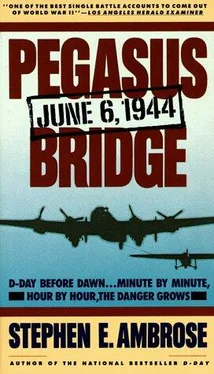Stephen Ambrose - Pegasus Bridge
Здесь есть возможность читать онлайн «Stephen Ambrose - Pegasus Bridge» весь текст электронной книги совершенно бесплатно (целиком полную версию без сокращений). В некоторых случаях можно слушать аудио, скачать через торрент в формате fb2 и присутствует краткое содержание. Жанр: История, на английском языке. Описание произведения, (предисловие) а так же отзывы посетителей доступны на портале библиотеки ЛибКат.
- Название:Pegasus Bridge
- Автор:
- Жанр:
- Год:неизвестен
- ISBN:нет данных
- Рейтинг книги:5 / 5. Голосов: 1
-
Избранное:Добавить в избранное
- Отзывы:
-
Ваша оценка:
- 100
- 1
- 2
- 3
- 4
- 5
Pegasus Bridge: краткое содержание, описание и аннотация
Предлагаем к чтению аннотацию, описание, краткое содержание или предисловие (зависит от того, что написал сам автор книги «Pegasus Bridge»). Если вы не нашли необходимую информацию о книге — напишите в комментариях, мы постараемся отыскать её.
Pegasus Bridge — читать онлайн бесплатно полную книгу (весь текст) целиком
Ниже представлен текст книги, разбитый по страницам. Система сохранения места последней прочитанной страницы, позволяет с удобством читать онлайн бесплатно книгу «Pegasus Bridge», без необходимости каждый раз заново искать на чём Вы остановились. Поставьте закладку, и сможете в любой момент перейти на страницу, на которой закончили чтение.
Интервал:
Закладка:
If Elsenhower's forces could break through that Wall, victory was not assured, but it was at least possible and even probable. If they could not get ashore, their chances were doubtful. Eisenhower said it well in his first report to the Combined Chiefs of Staff: 'Every obstacle must be overcome, every inconvenience suffered and every risk run to ensure that our blow is decisive. We cannot afford to fail.'
To meet the challenge, the United States, Great Britain, and Canada all turned the greater part of their energies to the task of launching an assault and establishing a beach-head. Their venture was code-named Operation Overlord; nearly every citizen of the three nations involved made a direct personal contribution to launching it.
As a consequence, Elsenhower's problems did not include a shortage of material. He had an abundant supply of tanks, guns, trucks. His problem was how to get them across the Channel and into battle. The tanks and heavy artillery could only be brought ashore gradually, especially on D-Day itself and for a few days after that. Thus, the Allied forces would be at their most vulnerable after the first wave had landed and before the follow-up waves got ashore with their tanks and guns. The troops themselves would be heavily outnumbered (by as much as ten to one) in the first days of the invasion, and as late as D-Day plus one month the ratio would be five to one. But many of the German divisions, fifty-five in all, were scattered all across France; many were immobile, and many were of low quality. Furthermore, Elsenhower could count on the Allied air forces to keep German movement to a minimum, at least in daylight. And he had chosen as the invasion site the area west of the Orne River: this avoided the bulk of German strength in France, which was north and east of the mouth of the Seine. In that area, and most of all around the Pas de Calais, German defences were strongest. In addition, the Germans had most of their panzer strength in the Pas de Calais.
Because the panzers were to the east, the most dangerous flank of the invasion for the Allies was the left flank. It was closest to the major German counter -attack formations and therefore the place where Eisenhower expected the most determined - and most dangerous - counter-attacks.
For immediate counter-attack purposes, Rommel had two armoured divisions, the 12th SS Panzer and the 21st Panzer, stationed in and to the east ofCaen. Elsenhower's greatest fear was that Rommel would send those divisions, operating as a coordinated unit, on a counter-attack against his left flank, code-named Sword Beach, just west of the mouth of the Orne River. It was possible that those two panzer divisions would drive the British 3rd Infantry Division on Sword back into the sea. It was also possible that, on D-Day plus one or two, additional panzer divisions would come into Normandy to participate in flank attacks along the beaches. They would strike first against Juno, then Gold, and finally the American beaches at Omaha and Utah. With fighting going on along the beaches, all Elsenhower's loading schedules would be disrupted.
To prevent such a catastrophe, Eisenhower expected to delay and harass the German tanks moving into Normandy by using the Allied air force, which had complete command of the air. The trouble was that the air forces could not operate either at night or in bad weather. By themselves, they would not be able to isolate the battlefield. Eisenhower needed some additional way to protect Sword Beach and his critical left flank.
To solve his problem, Eisenhower turned to another of the assets that Allied control of the air made available to him -airborne forces, extraordinarily mobile and elite units. German success with paratroopers and gliderborne troops in the first years of World War II had convinced the British and American armies of the need to create their own airborne divisions. Now Eisenhower had four such divisions available to him, the US 82nd and 101st Airborne and the British 1st and 6th Airborne. He decided to use them on his flanks: offensively to provide immediate tactical assistance by seizing bridges, road junctions, and the like; defensively to keep the Germans occupied and confused. The British 6th Airborne, dropping east of Sword Beach, had another critical task: setting up a blocking force to keep the German panzers away from the left flank.
Critical though those tasks were, they did not seem critical enough to George C. Marshall, the US Army Chief of Staff. Marshall was so strongly opposed to Elsenhower's plan that he sent Eisenhower what amounted to a reprimand - and was certainly the most critical letter he ever wrote to his protege. Marshall's criticism, and Elsenhower's response, bring out very clearly the advantages and disadvantages of airborne troops.
Marshall pointed out that the role assigned to the airborne forces was basically defensive, and stated flatly that he did not like the concept at all. No attempt was being made to engage or disrupt the enemy's strategic forces or counter -attack capability. Marshall told Eisenhower that when he was creating the 82nd and 101st, he had had great hopes for paratroopers as a new element in warfare, but he confessed that his hopes had not been realised, and now Elsenhower's plans made him despair. Marshall saw in the plan a wasteful dispersion of three elite divisions, with two American on the right protecting Utah's flank and one British on the left protecting Sword's flank. He charged that there had been a 'lack in conception' caused by a piecemeal approach, with General Omar Bradley insisting that he had to have paratrooper help at Utah and General Bernard Law Montgomery insisting that Sword Beach also had to have paratrooper aid.
This business of splitting up the paratroopers was all a mistake, Marshall told Eisenhower. If he were in command of Overlord, he would insist on one large paratrooper operation, 'even to the extent that should the British be in opposition I would carry it out exclusively with American troops'. He would make the drop south ofEvreux, nearly seventy-five miles inland from Caen. There were four good airfields near Evreux which could be quickly taken, making re-supply possible. 'This plan appeals to me', Marshall declared, 'because I feel that it is a true vertical envelopment and would create such a strategic threat to the Germans that it would call for a major revision of their defensive plans.' Bradley's and Montgomery's flanks could take care of themselves, in short, because the German tanks would be busy attacking the airborne troops around Evreux. Such a massive drop would be a complete surprise, would directly threaten both the crossings of the Seine and Paris, and would serve as a rallying point for the French Resistance.
The only drawback Marshall could see to his plan was 'that we have never done anything like this before, and frankly, that reaction makes me tired'. The Chief of Staff concluded by saying that he did not want to put undue pressure on Eisenhower, but did want to make sure that Eisenhower at least considered the possibility of making a bolder, more effective strategic use of his airborne troops.
Elsenhower's reply was long and defensive. He said that for more than a year one of his favourite subjects for contemplation had been getting ahead of the enemy in some important method of operation, and the strategic use of paratroopers was an obvious possibility. Marshall's idea, however, was impossible. First, Eisenhower insisted that Bradley and Montgomery were right: the flanks of the invasion had to be protected from German armoured counter-attacks. Second, and even more important, a paratrooper force three divisions strong landing seventy -five miles inland would not be self-contained, would lack mobility and heavy fire-power, and would therefore be destroyed. The Germans had shown time and again that they did not fear a 'strategic threat of envelopment'. Using the road net of France, Rommel could concentrate immense firepower against an isolated force and defeat it in detail.
Читать дальшеИнтервал:
Закладка:
Похожие книги на «Pegasus Bridge»
Представляем Вашему вниманию похожие книги на «Pegasus Bridge» списком для выбора. Мы отобрали схожую по названию и смыслу литературу в надежде предоставить читателям больше вариантов отыскать новые, интересные, ещё непрочитанные произведения.
Обсуждение, отзывы о книге «Pegasus Bridge» и просто собственные мнения читателей. Оставьте ваши комментарии, напишите, что Вы думаете о произведении, его смысле или главных героях. Укажите что конкретно понравилось, а что нет, и почему Вы так считаете.




![Stephen Ambrose - Citizen Soldiers [Condensed]](/books/346737/stephen-ambrose-citizen-soldiers-condensed-thumb.webp)




